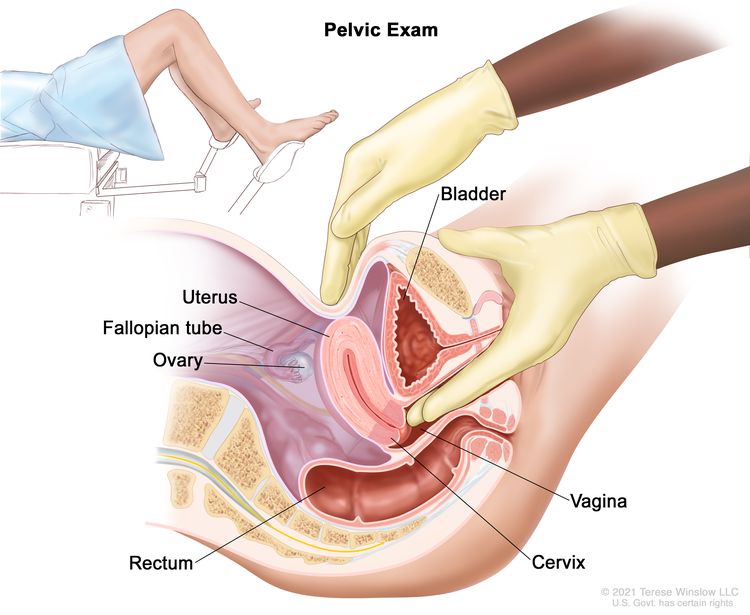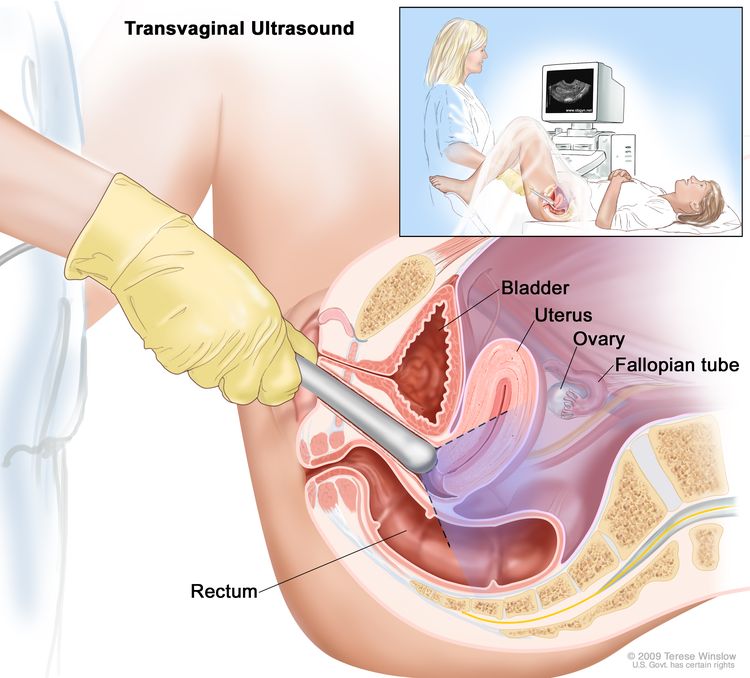Screening
Ovarian, Fallopian Tube, and Primary Peritoneal Cancers Screening
What is screening?
Screening is looking for cancer before a person has any symptoms. This can help find cancer at an early stage. When abnormal tissue or cancer is found early, it may be easier to treat. By the time symptoms appear, cancer may have begun to spread.
Scientists are trying to better understand which people are more likely to get certain types of cancer. They also study the things we do and the things around us to see if they cause cancer. This information helps doctors recommend who should be screened for cancer, which screening tests should be used, and how often the tests should be done.
It is important to remember that your doctor does not necessarily think you have cancer if he or she suggests a screening test. Screening tests are given when you have no cancer symptoms.
If a screening test result is abnormal, you may need to have more tests done to find out if you have cancer. These are called diagnostic tests.
General Information About Ovarian, Fallopian Tube, and Primary Peritoneal Cancers
Key Points
- Ovarian, fallopian tube, and primary peritoneal cancers are diseases in which malignant (cancer) cells form in the ovaries, fallopian tubes, or peritoneum.
- In the United States, ovarian cancer is the fifth leading cause of cancer death in women.
- Different factors increase or decrease the risk of getting ovarian, fallopian tube, and primary peritoneal cancers.
Ovarian, fallopian tube, and primary peritoneal cancers are diseases in which malignant (cancer) cells form in the ovaries, fallopian tubes, or peritoneum.
The ovaries are a pair of organs in the female reproductive system. They are located in the pelvis, one on each side of the uterus (the hollow, pear-shaped organ where a fetus grows). Each ovary is about the size and shape of an almond. The ovaries produce eggs and female hormones (chemicals that control the way certain cells or organs function).
The fallopian tubes are a pair of long, slender tubes, one on each side of the uterus. Eggs pass from the ovaries, through the fallopian tubes, to the uterus. Cancer sometimes begins at the end of the fallopian tube near the ovary and spreads to the ovary.
The peritoneum is the tissue that lines the abdominal wall and covers organs in the abdomen. Primary peritoneal cancer is cancer that forms in the peritoneum and has not spread there from another part of the body. Cancer sometimes begins in the peritoneum and spreads to the ovary.
Ovarian epithelial cancer, fallopian tube cancer, and primary peritoneal cancer form in the same type of tissue. Studies of screening tests look at these cancers together.

For more information about ovarian, fallopian tube, and primary peritoneal cancers, see the following:
In the United States, ovarian cancer is the fifth leading cause of cancer death in women.
While ovarian cancer is rare, it is the leading cause of death from cancer of the female reproductive system. The number of new cases of ovarian cancer decreased slightly each year from 1990 to the mid-2010s, but increased slightly each year from 2014 to 2018. There was a slight decrease in the number of deaths from ovarian cancer each year from 2015 to 2019.
Different factors increase or decrease the risk of getting ovarian, fallopian tube, and primary peritoneal cancers.
Anything that increases your chance of getting a disease is called a risk factor. Anything that decreases your chance of getting a disease is called a protective factor.
For information about risk factors and protective factors for ovarian cancer, see Ovarian, Fallopian Tube, and Primary Peritoneal Cancers Prevention.
Talk to your doctor about your risk of ovarian cancer.
Ovarian, Fallopian Tube, and Primary Peritoneal Cancers Screening
Key Points
- Tests are used to screen for different types of cancer when a person does not have symptoms.
- Screening tests have not been shown to decrease the chance of dying from ovarian cancer.
- Screening tests that have been studied include:
- Pelvic exam
- Transvaginal ultrasound
- CA-125 assay
- Screening tests for ovarian, fallopian tube, and primary peritoneal cancers are being studied in clinical trials.
Tests are used to screen for different types of cancer when a person does not have symptoms.
Scientists study screening tests to find those with the fewest harms and most benefits. Cancer screening trials also are meant to show whether early detection (finding cancer before it causes symptoms) helps a person live longer or decreases a person's chance of dying from the disease. For some types of cancer, the chance of recovery is better if the disease is found and treated at an early stage.
Screening tests have not been shown to decrease the chance of dying from ovarian cancer.
Screening tests that have been studied include:
Pelvic exam
Pelvic exams to screen for ovarian cancer have not been shown to decrease the number of deaths from the disease. A pelvic exam is an exam of the vagina, cervix, uterus, fallopian tubes, ovaries, and rectum. A speculum is inserted into the vagina and the doctor or nurse looks at the vagina and cervix for signs of disease. The doctor or nurse also inserts one or two lubricated, gloved fingers of one hand into the vagina and places the other hand over the lower abdomen to feel the size, shape, and position of the uterus and ovaries. The doctor or nurse also inserts a lubricated, gloved finger into the rectum to feel for lumps or abnormal areas.

Transvaginal ultrasound
Transvaginal ultrasound (TVU) to screen for ovarian cancer has not been shown to decrease the number of deaths from the disease. TVU is a procedure used to examine the vagina, uterus, fallopian tubes, and bladder. An ultrasound transducer (probe) is inserted into the vagina and used to bounce high-energy sound waves (ultrasound) off internal tissues or organs and make echoes. The echoes form a picture of body tissues called a sonogram.

CA-125 assay
A CA-125 assay is a test that measures the level of CA-125 in the blood. CA-125 is a type of biomarker (a substance released by cells into the bloodstream that may be a sign of a condition or disease). An increased CA-125 level is sometimes a sign of certain types of cancer, including ovarian cancer, or other conditions.
Studies have also shown that using CA-125 levels and TVU together to screen for ovarian cancer does not decrease the number of deaths from ovarian cancer.
Screening tests for ovarian, fallopian tube, and primary peritoneal cancers are being studied in clinical trials.
Information about clinical trials supported by NCI can be found on NCI’s clinical trials search webpage. Clinical trials supported by other organizations can be found on the ClinicalTrials.gov website.
Risks of Ovarian, Fallopian Tube, and Primary Peritoneal Cancers Screening
Key Points
- Screening tests have risks.
- The risks of ovarian, fallopian tube, and primary peritoneal cancers screening tests include the following:
- Finding ovarian, fallopian tube, and primary peritoneal cancers may not improve health or help a woman live longer.
- False-negative test results can occur.
- False-positive test results can occur.
Screening tests have risks.
Decisions about screening tests can be difficult. Not all screening tests are helpful and most have risks. Before having any screening test, you may want to talk about the test with your doctor. It is important to know the risks of the test and whether it has been proven to reduce the risk of dying from cancer.
The risks of ovarian, fallopian tube, and primary peritoneal cancers screening tests include the following:
Finding ovarian, fallopian tube, and primary peritoneal cancers may not improve health or help a woman live longer.
Screening may not improve your health or help you live longer if you have advanced ovarian cancer or if it has already spread to other places in your body.
False-negative test results can occur.
Screening test results may appear to be normal even though ovarian cancer is present. A woman who receives a false-negative test result (one that shows there is no cancer when there really is) may delay seeking medical care even if she has symptoms.
False-positive test results can occur.
Screening test results may appear to be abnormal even though no cancer is present. A false-positive test result (one that shows there is cancer when there really isn't) can cause anxiety and is usually followed by more tests (such as a laparoscopy or a laparotomy to see if cancer is present), which also have risks. Problems caused by tests used to diagnose ovarian cancer include infection, blood loss, bowel injury, and heart and blood vessel problems. A false-positive test result can also lead to an unneeded oophorectomy (removal of one or both ovaries).
Updated: March 31, 2023
This content is provided by the National Cancer Institute.
Source URL: https://www.cancer.gov/types/ovarian/patient/ovarian-screening-pdq


